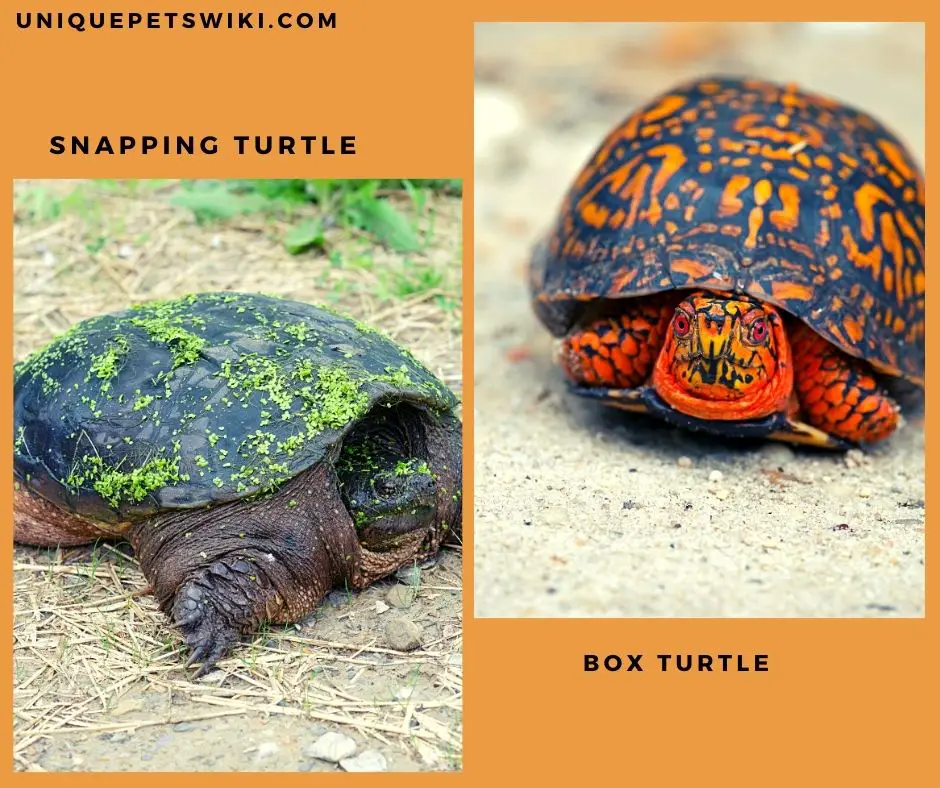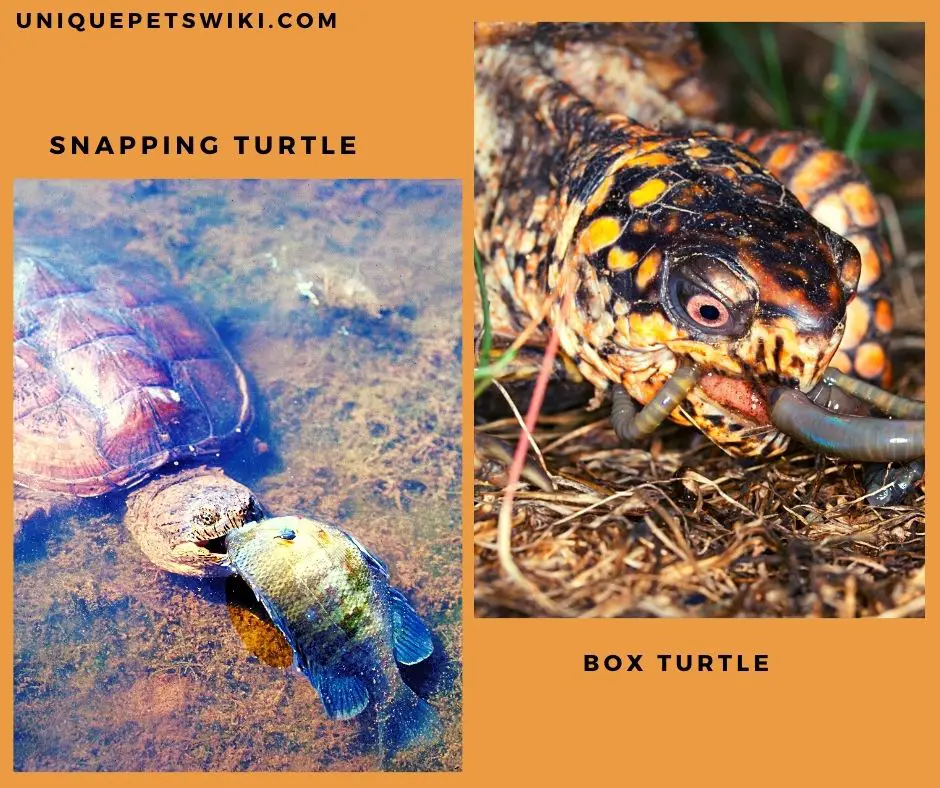I love turtles. They are charming, elegant, noiseless, meek, and peaceful creatures. But wait! Do you love them too? If you do, how do you know which turtle species is best for you? Between “Snapping Turtle Vs. Box Turtle” which will you go for? Read on to learn more!
I suggest you, too, are a turtle lover and admire waking up and seeing these sweet-natured creatures in your home. Or you want to know which one between snapping and box turtles will make an excellent pet.
Wooo! Am I right? Guess what! Turtles are bliss to adults and children. The snapping and box turtles are great pets, but we’ll find out the top-tier after seeing their differences.
Join me as we dive into this article and know which turtle pet to go for. Is it the snapping or box turtle?
Contents
Snapping Turtle Vs. Box Turtle: Full Comparison
The fact that snapping and box turtles are kept as pets. Knowing their considerable differences aids you in choosing the ideal turtle.
They say, ‘don’t be convinced by physical appearance without knowing what is enclosed inside. The same goes for our turtles of interest today; the snapping and box turtles.
Do not hasten to give credit to box over snapping turtles because they’re nice-looking. Wait and have their full details and yourself; you’ll love the decision you make in the end.
We have several aspects to consider but believe me, they’re essential for our judgment. Let’s have a look at each.
Appearance
Snapping and box turtles are pretty much different when it comes to their body conformation and color. Considering the shape, snapping turtles have a relatively flat top-shell or carapace, with a visible deep groove down the center.
Conversely, box turtles have a doomed and rounded carapace. Moreover, snapping turtles’ shells can be tan, dark brown, or even almost black. These turtles have extended necks and tails.

Box turtles primarily have dark brown or black shells with orange to yellow blotches or markings. Their screaming color makes them distinctive.
Shape, Size, and Weight
Snapping turtles can grow to a gigantic size, while box turtles are relatively small. For the box turtles, the average adult size is anywhere from 3.5-7 inches. At roughly 4-6 years, a box turtle has grown to its maximum size.
Snapping turtles tend to double or triple the size of a box turtle. Their average adult size falls between 8-18 inches. These turtles mostly reach their maximum size at around 12-15 years old.
What’s your guess of the weight of snapping and box turtles? Which one will weigh more than the other? The answer is pretty simple! Snapping turtles are huge and are therefore heavier than box turtles; their weight is relative to age and size.
At 4.5 inches in length, a box turtle usually weighs approximately 0.5-1.0 kgs. Snapping turtles are masters in weight. They tend to weigh about 5-16 kgs, but there is a record of some weighing more than 30 kgs.
The wild turtles from both species don’t weigh much because of the hard life there, but captivated species can grow beyond their weights indicated.
Native Range and Habitat
Could it be that despite being turtles, snapping and box turtles have dissimilar habitats? It might be or not. Let’s find out!
Snapping turtles feel more comfortable and at home in fresh or brackish water. They love habitats with shallow and slow-moving water, e.g., marshes, slow streams, lakes, creeks, pools, bogs, swamps, etc.
Moreover, these turtles’ habitats have muddy bottoms and plenty of vegetation to ease their work of hiding.
Box turtles are primarily terrestrial, and their natural habitats vary substantially from shrubby grassland, open woodlands, marshy meadows, and field forest edges. You can spot one under logs, bushes, or leaf litter.
These turtles are known to soak themselves in rivers, shallow ponds, and streams. Now you see that snapping turtles are aquatic and box turtle terrestrial. In captivity, the enclosure for each should mimic their natural habitats.
Growth Rate and Lifespan
It’s a joyous thing to hear that you will live with your dear pet forever. Alas, who on earth would celebrate knowing their pet is dying soon?
I take a pet’s longevity so seriously because I don’t want to cry for losing a pet consecutively. So, between a snapping and box turtle, which one lives longest?
Captivated snapping turtles have an estimated lifespan of 100 years, but their fellows in the wild live up to 30-45 years. A whole 100 years? Wow! They are even likely to outlive humans!

That means you will never worry about losing your snapping turtle at any time. I’m indeed impressed by this. Box turtles can spend a lifetime of 70-100 years or more when properly cared for as pets.
Now I see! Turtles are actually long-living reptiles. If you are looking for pets with a long lifespan, consider owning a turtle.
Predators
Hello there! Do you think turtles have predators even after possessing a very hard shell? Is there an animal that can break the shell and devour the turtle? Yes, turtles are prey to some animals.
Luckily, adult snapping turtles are only attacked by a few animals, e.g., coyotes, river otters, American alligators, and bears. But their hatchlings and eggs are targeted by a vast list of enemies, e.g., fish, crows, skunks, dogs, water snakes, birds, bullfrogs, raccoons, great blue herons, foxes, etc.
The box turtles’ ability to retreat into their shell gives them an advantage since they can escape many potential predators. However, they are threatened by raccoons, chipmunks, owls, foxes, and coyotes.
Active Level
Snapping turtles are primarily nocturnal; they spend much of their day in mud and vegetation. They prefer resting in muds and weeds for protection. They rarely bask during the day like most other aquatic turtles.
However, at night, these turtles are outside their habitat looking for food. The snapping turtles’ dark-colored skin and moss-covered shell are to be praised; they help these reptiles lie in wait and pounce on their prey.
Contrarily, box turtles are more active during the daytime and sleep at night. They are busy foraging for food, exploring the territory, and searching for mates in daylight hours.
Personality and Defense Mechanism
Box turtles are reputed for their distinct personalities and social nature. They form strong bonds with their favorite humans and can fairly recognize them.
Like other turtles, box turtles are contented seeing you around. They will relax and sit down instead of running to you for cuddling.
Snapping turtles do not have an excellent reputation when it comes to socializing with people. They are somehow aggressive even after living with you for many years. Both turtles are trainable in doing a few things, but it’s not an easy task.
Box turtles possess a very functional hinged-bottom shell. The hinge makes the shell close upon the squirrel drawing its legs, head, and tail inside. With this concealment ability, box turtles largely escape predation.
Snapping turtles cannot pull their legs, tail, and head inside the shell. Instead, they have a small-bottom shell that encourages the legs’ extension when in need of running speedily. They are very swift.
Swimming/Running Ability and Speed
Snapping turtles are great swimmers owing to the fact that they’re aquatic creatures. Moreover, these reptiles cannot retreat to their shell-like box turtles. Therefore, their primary defense mechanism is to run away from predators.
The average swimming speed of freshwater turtles, including snapping turtles, is 16-20 km/h. Their walking speed on the land reduces, usually around 3-4 km/h. However, the exact figures are not indicated.
The average swimming speed of freshwater turtles, including snapping turtles, is 16-20 km/h. Their walking speed on the land reduces, usually around 3-4 km/h. However, the exact figures are not indicated.

I’m sure with this speed; most predators are unable to catch up with them. These turtles are pretty fast in the water but a bit slow on land.
Box turtles are also fast runners. When covering a short distance, they can run at 0.4km/h speed. However, their average walking speed is only 0.27km/h.
Diet
Both the snapping and box turtles are omnivores; they eat a wide variety of plants and animals.
For instance, the box turtle food presences vary from spiders, apples, earthworms, slugs, mushrooms, snails, beetles, blackberries, strawberries, insects, etc. They require a formulation of 50% fresh veggies and fruits and 50% low-fat protein.
Snapping turtles are voracious meat-eaters and snacks on animals like spiders, snakes, carrions, frogs, birds, smaller turtles, worms, etc. They can also eat veggies and several fruits, e.g., bananas.

Brumation
Most turtles brumate when temperatures are slightly low to conserve energy to help them survive through the winter period. A turtle can brumate, whether in the wild or captivity, depending on the habitat conditions.
When brumating, these reptiles aren’t in a long and deep sleep; they can sense any changes to the environment.
Box turtles brumate in burrows and under logs while snapping turtles do the same in the bottom of ponds and lakes. Both can brumate for 4-6 months.
Mating
Snapping turtles are more active for breeding in warmer months. They typically breed between April and November. Courtship is expressed by males and females facing one another and switching their heads from side to side.
A male usually chases the female, grips the edge of her carapace firmly, and eventually, mating happens.
Box turtles tend to mate in spring, mostly when coming from hibernation. The males pursue a female, biting her on the head, neck, and posterior end of her shell, and then mount her.
Reproduction
Turtles are well known for not staying with their eggs; they typically lay and abandon the eggs in a particular place.
Snapping turtles tend to dig nests in dry and sandy areas, and this is where they bury their eggs after laying and go their way. On average, a snapping turtle lays 20-40 eggs, but some can lay even more than 100 eggs in a single nest.
Likewise, box turtles dig nests to hide their eggs. A female box turtle lays only one clutch per year, and each clutch has about 2-8 eggs.
Required Take Care
Snapping turtles are huge compared to box turtles, and therefore require a huge tank to stay comfortably.
Enclosure Size
Hatchlings live in a 10-gallon tank and juveniles of about eight inches in a 55-gallon tank.
The adults require a prettier complete change of water. For instance, a 2-foot deep by 4-foot-long pond-like enclosure is convenient for adults.
Box turtles can fit in a 40-gallon tank, but they thrive best in a tank of about 75 gallons. Hand-made cages also make good homes for box turtles.
Lighting, Heating, and Humidity Requirements
When setting an enclosure for any exotic pet, appropriateness is key. Produce a home that is no different from the natural habitat.
A standard UVB bulb, e.g., the 5.0 ReptiSun bulb, is better for adult snapping turtles and the 10.0 ReptiSun bulb for young turtles and hatchlings. Box turtles also require high-quality UVB lighting for 10-12 hours per day.
Snapping turtles thrive well in waters with temperatures between 75-85℉. The ideal temperature for box turtles ranges from 70-90℉, with the basking area reading 85-90℉.
Box turtles are comfortable in enclosures with a surface relative humidity of 80% and subsurface of 85%. The best humidity for snapping turtles is between 70-80%.
Last update on 2022-12-29 / Affiliate links / Images from Amazon Product Advertising API
Suitability: Best for Whom?
Snapping turtles are expensive to care for, and their hostile nature qualifies them to be handled by experienced owners rather than beginners.
But box turtles are not that bad for beginners. Their social nature and calmness give them credit for beginners to own them. Box turtles are also cheap to maintain because of their small size.
Cost
When thinking of owning a total, you need a breakdown budget of the turtle’s buying price, setting the ideal enclosure, and feeding cost. The upfront cost of turtles can range from $20-$200 depending on the seller, age, and breed of the turtle.
Expect to buy a snapping turtle from $40-$90, while the average buying price of box turtles ranges from $30-$70. Note that the prices can shoot up depending on several factors.
Ability to Keep in Groups
Box turtles get along well with their fellow counterparts and can live together, given that there’s ample space for each.
Snapping turtles are very solitary and are happy living alone. Ideally, even if some turtles can live together, it’s advisable to house these reptiles separately.
Can You Keep Snapping and Box Turtles Together?
Remember that these two species don’t live in similar habitats, and they have very different heat, lighting, and humidity requirements.
While snapping turtles are totally aquatic, box turtles live on land and only visit water bodies to soak themselves, and that’s all.
Therefore, you cannot keep a snapping and box turtle together. In fact, even turtles from the same species are more peaceful living alone.
Wrapping Up
Now that you have full details of the differences between snapping and box turtles, I wouldn’t stop you from making a judgment on which one to choose.
Box turtles have many attributes loved by many people, and that’s why they’re popular pet turtles. However, snapping turtles isn’t an exception; some people own them and make perfect pets.
Snapping turtles are ‘snappy’; they are more accustomed to the wild and may turn out to be very aggressive. But raising a snapping turtle from a young age helps it acclimate to captive life and live well with humans.
No pet owner is the same as another. We all have different preferences when it comes to owning pets. Some will say snapping turtles are the best, and others box turtles, and of course, with good reasons. Which one is your pick?


